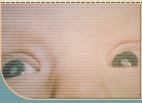
Visual Acuity Testing
PHASE 1: AGE 1 YEAR
When your child is about one year old, we will schedule an appointment for a special test. This test will give us a numerical measure of how well your child sees when each eye is tested separately. The testing will be done at your Clinical Center by our "traveling vision tester." We cannot expect infants to read an eye chart, but we are able to get them to tell us what they see. We are interested in this information because it will give us the first quantitative information about your child's vision with his/her contact lens or intraocular lens implant.
We need to determine how well your child sees with each eye separately. You will be asked to bring your child to the Clinical Center wearing his/her usual eye patch on the untreated eye. The patch should be placed on the eye at least one hour before the testing is scheduled to begin. Hopefully patching will have become routine for your child.
We will use a special method called the Acuity Card Procedure to determine how well your child sees. This test was developed and refined in the mid 1980s. It has proven very useful in our studies of infant vision. The cards we use are the Teller Acuity Cards . These cards are gray with a small peephole in the middle of them. To the left or right of this peephole is a square block of black and white stripes.
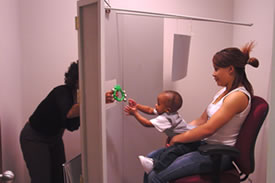 A special puppet stage
will be used. The reason for this stage is to minimize the distractions for your
child so it is easier for us to determine that he/she is looking at the stripes
on the Teller Acuity Cards. You will sit in front of a table-top screen or a
standing puppet stage holding your child. Your view of the cards will be blocked
so that you cannot unintentionally help your child find the stripes.
A special puppet stage
will be used. The reason for this stage is to minimize the distractions for your
child so it is easier for us to determine that he/she is looking at the stripes
on the Teller Acuity Cards. You will sit in front of a table-top screen or a
standing puppet stage holding your child. Your view of the cards will be blocked
so that you cannot unintentionally help your child find the stripes.
As far as your child is concerned, the testing is a game of peek-a-boo.
The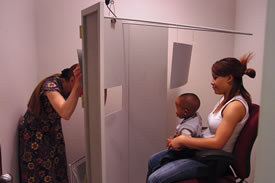 vision tester will
stand behind the screen and look through the peephole in the card. He/she will
show your child a series of these cards. Infants will readily look at these
patterns if they can see them. The tester will start with cards that have large
stripes and change to cards with smaller and smaller stripes. When the stripes
are small enough that your child cannot see them, the stripes will blend in with
the gray background. The tester will watch your child's eyes and face to
determine whether or not
vision tester will
stand behind the screen and look through the peephole in the card. He/she will
show your child a series of these cards. Infants will readily look at these
patterns if they can see them. The tester will start with cards that have large
stripes and change to cards with smaller and smaller stripes. When the stripes
are small enough that your child cannot see them, the stripes will blend in with
the gray background. The tester will watch your child's eyes and face to
determine whether or not 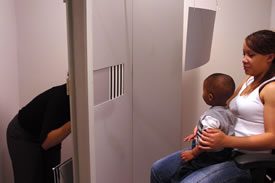 he/she can see the stripes. We will schedule about an hour for the
testing session. The actual testing can take as little as 2 minutes or as much
as 10 to15 minutes for each eye.
he/she can see the stripes. We will schedule about an hour for the
testing session. The actual testing can take as little as 2 minutes or as much
as 10 to15 minutes for each eye.
The person doing the testing will be traveling from our Vision Testing Center which is located at the University of Alabama at Birmingham . Your Clinical Coordinator will work with you to determine the best testing schedule for you and your child as well as one which meets the study requirements. The traveling tester will arrange her time based on this scheduled appointment.
PHASE 2: AGE 4.5 YEARS
When your child is about 4 1/2 years old, we will again test the vision in both eyes using a different system that requires a response from your child. This type of test uses a video monitor for displaying the letters which are presented in an order determined by a computer. Single letters with surround bars are presented on the video monitor and this is set at a distance of 3 meters (about 10 feet).
The test is divided into two parts. The first part is referred to as a "screening" phase during which the visual acuity is estimated in order to make the testing more efficient and less time-consuming. Part two gives the actual visual acuity.
Some children may prefer to sit on the parent's lap for the testing. This is acceptable, but the parent should be informed that the child does not need to identify the letters by name and that there will be some letters that the child cannot see. Each eye will be covered for testing by having the child wear a pair of "sunglasses." There will be two separate frames that hold a cover over either the right eye or the left eye.
Children will be given the matching card and instructed to look at the monitor and then point to the letter on the card that matches what they just saw on the monitor. Some children have difficulty with shifting attention between the monitor at a distance and the matching card in their hands. The tester may need to hide the letters by holding the matching card away from the child, or flipping it over to the back which is blank. After the child has clearly directed his/her attention to the monitor, the tester can turn the matching card face up and ask the child to point at the letter s/he had just seen - "which one was it?"
This test will be administered by the traveling tester from the study Vision Testing Center at the University of Alabama in Birmingham. Dr. Hartmann will train this individual on the video system that is available in the UAB School of Optometry Eye Care Pediatric Clinics.
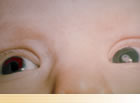
Patching
#1 - FAQ's
#2 - TIPS
#3 - Practicalities
#4 Video
Glasses
#1 Guidelines
#2 Spectacles
Contact Lenses
#1Contact Lenses
#2Contacts Video
Diary
#1 Eye Care Diary
#2 Detailed Diary Instructions
#3 Diary Video
Tips for Visual Acuity Testing